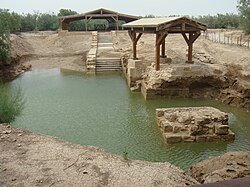Al-Maghtas
| Al-Maghtas | |
|---|---|
|
Native name Arabic: المغطس |
|

Excavation of baptism site
|
|
| Location | Jordan River, Jordan |
| Coordinates | 31°50′14″N 35°33′01″E / 31.837109°N 35.550301°E |
| Website | baptismsite.com |
| Official name: Baptism Site "Bethany Beyond the Jordan" (Al-Maghtas) | |
| Type | Cultural |
| Criteria | III, VI |
| Designated | 2015 (39th session) |
| Reference no. | 1446 |
| State Party | Jordan |
| Region | Arab States |
Al-Maghtas (Arabic: المغطس), meaning "baptism" or "immersion" in Arabic, is an archaeological World Heritage site in Jordan on the east bank of the Jordan River, officially known as Baptism Site "Bethany Beyond the Jordan" (Al-Maghtas). It is considered to be the original location of the Baptism of Jesus and the ministry of John the Baptist and has been venerated as such since at least the Byzantine period.
Al-Maghtas includes two principal archaeological areas. The remnants of a monastery on a mound known as Jabal Mar-Elias (Elijah's Hill) and an area close to the river with remains of churches, baptism ponds and pilgrim and hermit dwellings. The two areas are connected by a stream called Wadi Kharrar.
The strategic location between Jerusalem and the King's Highway is already evident from the Book of Joshua report about the Israelites crossing the Jordan there. Jabal Mar-Elias is traditionally identified as the site of the ascension of the prophet Elijah to heaven. The complete area was abandoned after the 1967 Six-Day War, when both banks of the Jordan became part of the frontline. The area was heavily mined then.
After the signing of the Israel–Jordan peace treaty in 1994, de-mining of area soon took place after an initiative of Jordanian royalty, namely Prince Ghazi. The site has then seen several archaeological digs, 4 papal visits and state visits and attracts tourists and pilgrimage activity. In 2015, the site was designated as a World Heritage site by UNESCO, excluding the western side of the river. Approximately 81,000 people visited the site in 2016, mostly European, American and Arab tourists. Thousands flock to the site on January 6 to mark Epiphany.
...
Wikipedia

